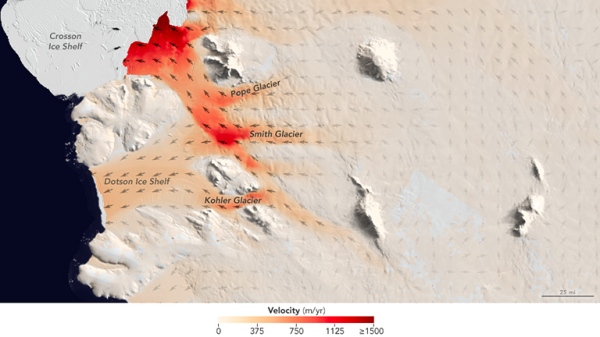Half a Kilometer of Ice Gone in Just 7 Years — West Antarctica’s Smith Glacier Points To Nightmare Melt Scenario
26
October, 2016
The
nightmare global warming melt scenario for West Antarctica goes
something like this —
First,
ocean waters warmed by climate change approach the vast frozen
continent. Melt already running out from the continent forms a fresh
water lens that pushes these warmer waters toward the ocean bottom.
The waters then get caught up in currents surrounding Antarctica that
draw them in toward numerous submerged glacial faces. The added ocean
heat combines with falling melting points at depth to produce rapid
melt along sea fronting glacier bases. Since many of these glaciers
sit on below sea level beds that slope downward toward the interior
of Antarctica, a small amount of initial melt sets off an inland
flood of these warmer waters that then produces a cascade of melt.
This glacial melt chain reaction ultimately generates a Heinrich
Event in
which armadas of icebergs burst out from Antarctica — forcing
global sea levels to rapidly rise.
This
is Why We Worry So Much About Multi-Meter Sea Level Rise
Ultimately,
seas rising by multiple meters this Century are a very real
possibility under current warming scenarios in which such a series of
cascading melt events occurs in West Antarctica.
(NASA
video narrated by Dr.
Eric Rignot,
a prominent glacial scientist. Concerns about the origin of melt
water pulse 1A during the end of the last ice age led to
investigation of large Antarctic melt pulses as a potential source.
Subsequent investigation identified melt vulnerabilities at the bases
of large sea fronting glaciers in West Antarctica to present and
predicted levels of ocean warming. At issue was the fact that bottom
waters were warming and that because many glaciers rested on sea beds
that sloped inland, melt rates had the potential to very rapidly
accelerate.)
Though
such a nightmare melt scenario was recently theoretical, it
represented a very real potential near-future event as global
temperatures rose into the 1-2 degrees Celsius above 1880s range
during recent years. For times in the geological past around 115,000
years ago also produced large glacial melt pulses and related sea
level rises of 15-25 feet during periods of similar warmth.
However,
direct evidence of such a powerful melt dynamic had not yet been
directly observed in Antarctica’s glaciers. Fresh water lenses were
developing, rates of glacial loss were quickening. Basal melt rates
looked bad. But the kind of tremendous losses necessary to produce
rapid sea level rise were not yet fully in evidence.
Smith
Glacier Loses Half a Kilometer of Ice in Sven Years
That
situation changed during recent weeks when two
scientific papers broke the news that some of West Antarctica’s
glaciers had lost upwards of a half a kilometer of ice thickness due
to contact with warm ocean waters over the past decade.
The
studies, entitled Rapid
Submarine Ice Melting in the Grounding Zones of Ice Shelves in West
Antarctica and Grounding
Line Retreat of Pope, Smith and Kohler Glaciers took
a comprehensive look at both surface and underside melt of three
major west Antarctic glaciers near the Thwaites and Pine
Island Glacier systems.
These glaciers included Pope, Smith and Kohler — which have seen
increasing instability and rates of seaward movement during recent
years. Using multiple instruments, the scientists found evidence of
massive ice losses and speeding ice flows.
(Surface
velocity of Kohler, Smith and Pope Glaciers provided by NASA.
More rapid seaward movement of glaciers = faster rates of sea level
rise.)
The
losses occurred at a time when an influx of warmer water (warming
circumpolar deep water)
was heating the ice shelves and grounding lines buttressing these
three partially submerged glaciers. This warming was found to have
produced melt along the grounding zones of these glaciers in the
range of 300 to 490 meters from 2002 to 2009. In other words, about
1/3 to 1/2 a kilometer of ice thickness at the grounding line was
lost in just seven years. Melted away from below by warming deep
ocean conditions at
the rate of up to 70 meters or around 230 feet per annum.
The
studies found that the Pope and Kohler glaciers, which rested on
up-sloping sea beds, produced slower rates of melt. While Smith,
which sat on a retrograde (or down-sloping bed)produced
very rapid rates of melt. According
to the Nature study:
We attribute the different evolution of Smith Glacier to the retreat of its grounding line deeper allowing warmer waters to flood its grounding zone, and increasing ocean thermal forcing due to the lowering of the in situ melting point; as well as to the exposure of the glacier bottom to ocean water as the grounding line retreated rapidly.
A
Context of Worsening Risk
Unfortunately,
numerous glaciers in the Amundsen Sea region including parts of the
Thwaites system and the massive Pine Island Glacier also sit on
retrograde slopes. These glaciers are seeing increasing fluxes of
warm, deep water. By themselves they represent multiple feet of sea
level rise (4-7 feet). Furthermore, Thwaites and Pine Island Glacier
currently buttress a number of massive inland glaciers that become
vulnerable to melt if inland-running retrograde slopes become flooded
with warming ocean waters.
The
very real concern is that Smith Glacier serves as a harbinger for
near future events to come. As a result, coastal regions around the
world are now under a heightened risk of swiftly rising seas and
rapid coastal inundation over the coming years and decades.
Links:
Hat
tip to Zack
Labe
Hat
tip to Miles h




No comments:
Post a Comment
Note: only a member of this blog may post a comment.